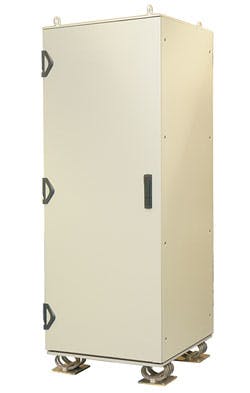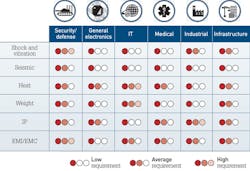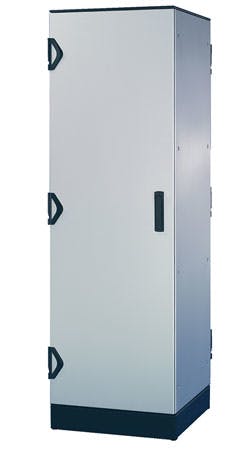Critical factors to consider when specifying a cabinet solution
From the January, 2015 Issue of Cabling Installation & Maintenance Magazine
Design components, industry regulations, and environmental factors all come into play when determining the best 19-inch electronics cabinet solution for your data center.
By Marc Caiola, Pentair Electronics Protection/Schroff
With today's powerful electronics generating more heat and increased power consumption, it is essential to specify and deploy an effective 19-inch cabinet solution that ensures consistent performance and protection. Preferably, these include cabinet solutions that are specifically designed to accommodate a variety of unique environmental conditions, such as extreme heat, high dust/moisture, radio-frequency/electromagnetic interference (RFI/EMI), and high shock and vibration.
Using 19-inch cabinets that are designed for robust protection of sensitive electronics is an effective way to ensure continuous operation while minimizing the risk of downtime resulting from operational failure. With a wide variety of available cabinet configurations and protection features, design engineers may tailor an ideal cabinet solution that meets or exceeds their specific application requirements.
When selecting a 19-inch cabinet, it is important to factor in essential mechanical structure and protection standards-design considerations. This article will discuss critical design considerations, industry-recognized standards, thermal management, seismic, shock and vibration, and electromagnetic compatibility.
Cabinet structure
Nineteen-inch cabinets provide a standardized frame or enclosure for mounting various types of electronics equipment. Each piece of equipment is typically 19 inches (482.6 mm) wide, including edges or mounting ears, which allow for mounting to the rack frame. Cabinet height is identified in "Units" (U), each unit equal to an industry standard of 1.75 inches (44.45 mm). Rack-mountable equipment is usually designed to occupy a specified number of U. For example, a piece of test equipment may be 4U high, most rack-mountable computers are between 1U and 5U, and some high-availability computing solutions may need as much as 13U. Cabinet depths may vary in accordance with diverse applications; however, typical depths range from 600 to 1,200 mm.
The amount of weight loaded into a cabinet can vary widely, so it's important to take a look at this factor to determine the right type of cabinet for a given application. Whether it is several banks of batteries for uninterruptible power supplies (UPS), or an array of hard drives, proprietary equipment or other heavy components, underestimation of weight loading requirements is a very common frustration for engineers. Weight load poses a special challenge because heavy equipment may be loaded at the bottom of a cabinet to obtain optimal testing results, but this arrangement may not correspond with the final configuration.
Industry design standards
Design standards are defined and developed by standards committees, government agencies and regulators to identify specifications that a product or service should adhere to. Recognized at both domestic and international levels, these standards are widely adopted by engineers, manufacturers, trade organizations, testing laboratories and other vested parties. This article segment will identify the key standards for 19- inch cabinets.
The International Electro-technical Commission (IEC) develops international standards for all electrical, electronic and related technologies. Adoption is voluntary, although they are often referenced in national laws or regulations around the world. For 19-inch cabinets, the standard IEC 60297 (Mechanical Structures for Electronic Equipment – Dimensions of Mechanical Structures of the 482,6mm/19-inch Series), provides crucial information for designing 19-inch cabinets. The standard specifies the basic dimensions of front panels, subracks, chassis, racks and cabinets of the 19-inch series. Subsequent standards of the associated IEC 60297-3 series provide detailed dimensions for specific parts of the equipment practice, where the basic dimensions are used as interface to other associated parts.
In addition to IEC, the National Electrical Manufacturers Association (NEMA) is the association of electrical equipment and medical imaging manufacturers. Founded in 1926, NEMA includes more than 400 member companies and provides a forum for developing technical design and safety that are in the best interests of the industry and users.
NEMA standards cover corrosion resistance, ability to protect from rain and submersion, and other key requirements. IEC 60529 provides guidance for classifying the ingress protection rating (IP Codes) of enclosures. Together, IP and NEMA address dust and water protection. Equipment that has better protection against dust/objects and water will have higher IP ratings. IP ratings have two numbers--one shows dust/object protection and the other shows water protection. NEMA, on the other hand, has pre-established ratings for both.
Network Equipment-Building System (NEBS) is not a regulatory requirement, but more of a best-practices standard that became widely referenced in the telecom industry. It is the most common set of safety, spatial and environmental design guidelines applied to telecommunications equipment in the United States.
Telcordia (now part of Ericsson) manages specifications and provides a series of General Requirements (GR) for communications electronic and mechanical solutions. Key cabinet requirements include NEBS GR-63-CORE (physical protection, such as thermal load calculation and seismic Zone 4) and GR-1089-CORE (electromagnetic compatibility and electrical safety).
Underwriters Laboratories ( UL) is a global independent safety consulting and certification company that focuses on ensuring electrical safety standards. UL provides safety-related certification, validation, testing, inspection, auditing, advising and training services to a wide range of clients, including manufacturers, retailers, policymakers, regulators, service companies, and consumers.
Restriction of Hazardous Substances (RoHS) originated in the European Union and restricts the use of six hazardous materials found in electrical and electronic products. These materials include lead (chemical symbol Pb), mercury (Hg), cadmium (Cd), hexavalent chromium (Cr VI), polybrominated biphenyls (PBB) and polybrominated diphenyl ethers (PBDE).
MIL-S-901-D is a special military test requirement designed for shipboard applications. Based on the type of equipment--essential or non-essential to the safety and combat-readiness of the ship--qualification testing is performed on a specified machine placed on a barge floating in a pond where explosive charges are detonated at various distances and depths in the pond to impart shock upon the equipment.
Thermal management and cooling
With today's electronics' increase in power density and heat, thermal management and cooling is critical. Thermal overload can be a common reason for operating failures in electronic devices and the risk increases for equipment mounted into cabinets. Heat dissipation calculations are measured in ΔT (Delta T), which is defined as the temperature difference between the intake air and exhaust air, or the amount of heat that is carried away by the stream of air exiting the heat load. A greater temperature difference signifies more heat being removed. An ideal formula for calculating heat dissipation requirements within a cabinet is Watts = 0.316 x CFM x ΔT (CFM = cubic feet per minute).
In today's systems, the higher density of processors and electronic components, as well as added processing power, increases operating temperatures and requires more energy for power and cooling. Smaller system footprints also put a strain on cooling systems, increasing the risk of thermal failure. Studies have shown that for every 10-degree Celsius/18-degree Fahrenheit rise above normal room temperature (22.2 degrees to 23.9 degrees C/72 to 75 degrees F), the life expectancy of enclosed electronics components is reduced by 50 percent.
Cabinets designed for universal applications require broad thermal management compatibility and often need to meet more-stringent performance demands than standard communications cabinets. There are numerous thermal management and cooling options that may be deployed in cabinets--from high perforation, which is referred to as a passive option, to fan trays, heat exchangers and air conditioners, which are considered active options.
Additional information regarding heat management design standards and recommendations are identified in IEC 61587-1 and NEBS GR-63. Additionally, IEC 62454 describes framework conditions and details calculated examples for applications with air/water heat exchangers that are assembled in either the base or on the side of the cabinet.
Shock and vibration
When considering 19-inch cabinets with shock and vibration protection, it is important to note there are two main dynamic requirements--seismic and shock/vibration (S/V) tests. These tests are very different and have very well-defined processes on loading cabinets with weight. Retesting with exact equipment is needed to ensure that the final solution offers the same S/V or seismic protection as desired. The test may not be needed if the equipment is below the threshold of the official test. Although tests might look very simple and rudimentary, they deal with very complicated issues of wave forms, material structure and material fatigue.
Shock and Vibration--This test is a go-to test for equipment that will be used in mobile applications and simulates a typical environment in a train car, vehicle or next to vibration-generating equipment such as a punch press or other piece of industrial equipment. Minimization of weight and S/V-optimized designs offer long-term benefits to users, especially in transportation applications.
Seismic--Seismic activity is a very complicated, but well- studied phenomenon. Testing equipment and processes are well-defined and well-known with multiple laboratories capable of doing tests. The test consists of placing a fully loaded, standard cabinet on a platform that can move in any direction and simulate the earth's movements during a seismic event. Certain deformation and movement of the cabinet can lead to test failure.
EMI has been a growing concern with equipment manufacturers. As equipment becomes faster and proliferates into all types of manufacturing and production environments, the issue of EMI has become more prevalent. Environments that were once considered EMI-free are becoming more and more susceptible to interference due to an increase in automation equipment and electronics emissions. Visual inspection alone of cabinet gaskets does not suffice to ensure adequate EMI protection.
Proper tests and results are needed to ensure that a cabinet design meets those requirements. Gasket integration to provide a Faraday effect is not a simple matter--competing with requirements such as cabinet cooling and perforations for air flow. Achieving proper air flow demands an understanding of the entire system, not just individual components, and necessitates a number of accessories that may seem redundant but solve very specific problems. Additional design requirements and recommendations can be referenced in IEC 61587-3 and GR-1089.
When selecting 19-inch electronics cabinets, it is critical to analyze several factors, including design components, industry regulations and recommendations, and environmental factors such as cooling, shock and vibration, and EMC protection.
Marc Caiola is platform and market leader for North America with Pentair Electronics Protection/ Schroff (www.pentairprotect.com). Pentair PLC delivers products, services, and solutions in water and other fluids, thermal management, and equipment protection. Pentair, Hoffman, Design with Confidence, and Schroff are owned by Pentair or its global affiliates.
Archived CIM Issues



